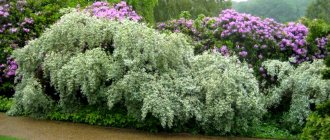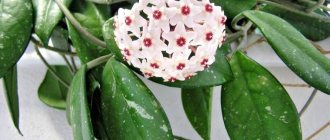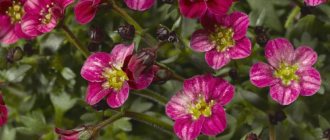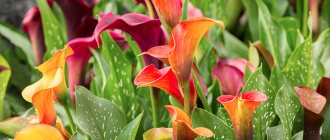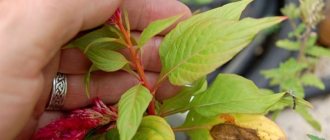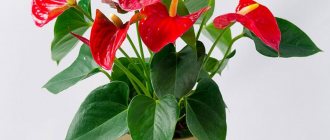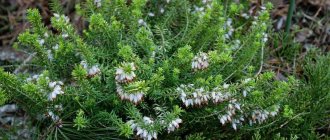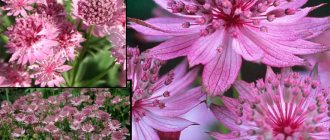Delphinium flowers are an interesting plant, which is also popularly called “living lace.” There are more than 450 species, there are both annual and perennial specimens. Despite the fact that you can find a huge number of reviews on the Internet that flowers are unpretentious and grow everywhere, this is far from the case. Without tricks and the application of rules, it is very difficult to grow such beauty on your own plot. This article provides basic information on how to grow and care for the King of Blues.
Brief overview of the article
- A little history
- What Science Says
- Peculiarities
- Reproduction
- Propagation by seeds
- What should the soil be like?
- Feeding and care
- What to do at the end of the season
- Variety 'Princess Caroline'
- For whom is it dangerous?
- Photos of delphiniums
A little history
Once upon a time, a young sculptor’s girlfriend died. To capture her memory, he created a stone sculpture on the seashore. To be able to speak with his beloved and her soul, he breathed life into the stone.
The angry gods, who had the ability to decide destinies, turned him into a dolphin. Every year, the young man went to the shore to talk to the stone. On one of these visits, he brought a beautiful flower and left it at the foot of the tree.
The flower was unusual, its beauty was like “sea blue”. After this, the entire shore was overgrown with this plant, and the people who came called it “delphinium”. A photo of a perennial delphinium can be seen below.
What does a perennial delphinium look like?
Delphinium, spur or larkspur (Delphinium), is a perennial herbaceous plant of the Ranunculaceae family. It has a strong, straight stem, the leaves are palmately divided, dissected into jagged or pointed lobes.
Delphinium flowers are collected in racemes or panicles, consist of five sepals, the upper one has a cone-shaped appendage - a spur with nectaries. Usually the buds have a purple or blue tint, but decorative varieties have other colors.
Delphinium belongs to the category of poisonous plants, but is also a honey plant.
Perennial delphinium is widespread in the Northern Hemisphere and is also found in the mountainous regions of tropical Africa and China. It is represented by several hundred species, most of which have medicinal properties.
Height of delphinium perennial
The height of larkspur depends on the specific variety. Some plants rise only 10 cm above the ground, others rise up to 2-3 m.
When does perennial delphinium bloom?
The decorative period of delphinium begins at the end of May or June. The buds open gradually from the base of the peduncle to the top, so with proper care the plant retains its attractiveness for quite a long time.
What Science Says
This wonderful story can be diluted with scientific facts. The plant is most often found in Africa and Asia. Due to their beauty, new species began to actively grow in Russia and other, colder countries. Most of the wild species that remain in the tropics are toxic and very dangerous.
The flower has a very understandable name; the inflorescences are very similar to the head of a dolphin. You can find folk references in different countries; in Russian-speaking territory it is known as “Spurnik”. Planting and caring for perennial delphinium is possible even with minimal experience.
Description
Delphinium belongs to the buttercup family.
The unopened flower buds resemble the head of a dolphin, hence the name of the plant. There is another version of the appearance of the name. In the vicinity of the Greek city of Delphi, located at the base of Mount Parnassus, a huge number of these flowers grew. The city was famous for the temple of Apollo. This is how the culture was named in honor of the city and the temple - the flower of Delphic Apollo. The natural habitat is quite wide - China, Siberia, Mongolia, Europe. The plant feels comfortable in forest clearings and outskirts, along streams, and in mountain meadows.
A rigid, erect stem emerges from the thick fibrous roots of the delphinium. It does not branch and can be either pubescent or non-pubescent. The leaves are attached to the stem using a petiole, located oppositely. They are quite large, with a jagged or smooth edge, finger-pinnate in shape.
A special decoration are flowers of various colors - blue, white, pink, purple. They can also be two-tone, soft pastel colors or bright “screaming” shades.
The flowers are collected in one pyramidal inflorescence. Its length can reach 100 cm. The diameter of an individual flower ranges from 4 to 6 cm. Spur flowers can be simple or double, depending on the species. Flowering occurs in June-July. Fragrant flowers attract many insects.
Delphiniums are not suitable for food as they are poisonous. The plant is also dangerous for herbivores.
Peculiarities
The plant prefers sunny areas, protected from strong winds. Finding something like this on the site is quite possible, especially if there are additional buildings. To avoid drying out, the shade should touch the flowers for at least 2-3 hours in dry summers.
Many of the species bloom several times a year. In normal environment:
- In early May, with stable above-zero temperatures.
- In mid-autumn, before frost reaches the region.
Additionally, it is worth highlighting frost resistance. The plant will calmly survive a harsh winter, but spring and the coming thaw will not.
Everything is complicated by the fact that the root system is at risk due to its structure. While in many plants it goes deep, here it is located at the very surface. Therefore, you cannot flood flowers.
Caring for delphinium seedlings
To successfully grow healthy and strong delphinium seedlings at home, it is necessary to carry out proper and regular care after planting the seeds. However, the conditions before and after emergence are different. Let's take a closer look.
Care after sowing and before emergence
After sowing delphinium seeds, the container should be kept in the refrigerator for 10-14 days . Such conditions will help to get seedlings faster, and stratification also strengthens the immunity of seedlings. Regularly check and moisten (as necessary, when the soil dries out) the crops in the refrigerator, and as soon as the shoots appear (after about 10-14 days), you need to remove the polyethylene and the lid, and transfer the seedlings to a bright room where the temperature is maintained at 15-18 degrees of heat.
Care after emergence
In order to properly care for delphinium seedlings after emergence, the following conditions should be provided:
- Temperature regime . Carefully monitor the room temperature, it should not be lower than +18°C and not higher than +20°C . Decreasing or increasing t will negatively affect plants or even cause their death.
- Lighting . The seedlings should be in a well-lit place; south or south-west windows are ideal. The duration of daylight hours should be 12-14 hours , so if necessary, additionally illuminate the seedlings using a phytolamp or at least LED lamps.
- Watering . Carefully monitor the soil moisture; it should not dry out. At the first signs of drying out of the top layer of soil, moderately water at the root; you can water in this way using a syringe.
- Loosening . Lightly loosen the soil surface regularly.
Reproduction
Here are the classic methods of reproduction:
- Cuttings.
- Delphinium perennial seeds.
- Dividing the bush.
The latter option is possible in cases where the plant has already lived for more than 3 years. The plant is dug up in the spring, when it reaches 15 cm. The rhizome is divided into several parts so that each has 2-3 shoots. The separation areas are washed with water and then treated with an activated carbon solution.
You can’t plant it in open ground right away; you need to leave it in a pot in the house. The mixture is simple: black soil and sand (1 to 1). After 2-3 days you can move it outside.
Answers to frequently asked questions
Is stratification of delphinium seeds necessary before sowing?
No, stratification before sowing is not necessary, but this procedure significantly increases seed germination.
How to mulch the soil after planting delphinium outside?
For mulching, humus or peat is suitable, a layer 3 cm thick.
It is recommended to store the seeds in cool places, but won't they freeze and lose their functions?
Quite the opposite: experts have proven that low temperatures allow delphinium seeds to retain their properties much longer. You can put the seeds in a bag and store them on the bottom shelf of the refrigerator.
Propagation by seeds
Each variety has its own characteristics, so it is advisable to read the instructions on the package before planting. Planting “homemade” seeds is a waste of time, so it is better to purchase a certified product. Instructions:
- In March, the owner collects the soil mixture (you can buy ready-made). If you do it yourself - humus, sand, black soil, all in equal quantities.
- Seeds can be immediately planted 0.5 cm deep.
- Seating is 5-7 cm apart.
Already in May, young shoots can be transferred to open ground. To germinate seeds, use a regular spray bottle. In this case, it will not be possible to overfill the soil. The perennial delphinium flower will delight you by the end of spring.
When to plant delphinium seedlings, in what month
When is the best time to sow crops at home? The optimal time for sowing delphinium seeds is approximately the end of February - beginning of March . But in different regions, planting time varies, since there are different weather and climatic conditions:
- in the middle zone (including the Moscow region) it is better to sow in mid-March;
- in Siberia, the Urals, and the Leningrad region at the end of March;
- but in the South it is optimal to sow seeds at the end of February.
The 2022 Lunar calendar will also help you choose the appropriate timing for planting delphinium seedlings
- Favorable days: in January: 1, 10, 11, 15, 16, 19, 20;
- in February: 7, 8, 12, 13, 14, 15;
- in March: 10, 11, 15, 20, 21, 24, 25.
- Unfavorable days: in January: 2, 18th;
- in February: 1, 16;
- in March: 2, 16, 17, 18, 31.
What should the soil be like?
Speaking about common species that tolerate frost and drought well, we can highlight the importance of soil. Flowering and the absence of problems depend on it. Which one is needed:
- Neutral or slightly acidic.
- If the soil is low acidic, be sure to add a little lime (150 g per 1 sq.m.).
- Fertilizer - manure or compost.
When planting, the distance between the holes should be at least 40 cm. The plant grows well, so that the root system does not get tangled, the minimum should be observed.
Perennial delphinium seedlings will take root if the plant is germinated within the same area. For example, you can take it from a neighbor or purchase it at the market in one village.
What to do with delphinium after flowering
When the leaves dry after flowering, the stems must be cut off at a height of up to 45 centimeters from the ground. For reliability, the top is lubricated with clay. This is done to prevent rain from damaging the root collar. It is worth noting that almost all types of larkspur are resistant to cold, even seedlings.
If the winter is snowless and frosty, the beds should be covered with straw or spruce branches. To protect against temperature changes, it is necessary to pour half a bucket of sand into the bottom of the hole during planting. This will allow excess moisture to drain away.
Feeding and care
The most labor will have to be spent on a young plant. In the first few years, you will have to feed 3 times per season:
- At the beginning of spring, superphosphate – 60 g, ammonium nitrate – 10 g, potassium chloride 20 g and ammonium sulfate 25 g are added per 1 sq.m.
- Before the buds appear - superphosphate and potassium, 25 g in total.
- Usually done in August, repeating the first feeding.
The plant loves moisture, but the rhizome should not be overwatered. Therefore, in summer it is better to water when it gets dry. It is advisable to plant in elevated areas so that water does not accumulate after rain.
Diseases and pests
Proper care and preventive measures will protect the delphinium from insect pests. It is necessary to remove plant debris in a timely manner and prevent plantings from becoming thicker.
The plant is loved by slugs and snails. To protect the spur from uninvited guests, you need to scatter broken eggshells or basalt flour under the bush.
The threat to the perennial is posed by the blue-green larkspur aphid and the chrysanthemum nematode.
Among the diseases that affect delphinium are fungal infections (powdery mildew) and bacterial infections (black leaf spot).
What to do at the end of the season
When the plant has completely faded, usually in late autumn, it needs to be pruned. Don’t be afraid, cut off the entire flowering part, leaving small cuttings of 5 cm.
If the climate in the area is moderate, then you don’t have to worry, the plant will not freeze. Flowers can easily withstand up to -40 degrees. However, if there is high humidity in the area (rains, constantly melting snow), then it is advisable to plant them in advance on a hill so that the water does not stagnate.
The rhizome, due to its intricate and fragile system, quickly rots and is susceptible to the influence of insects, diseases, and fungi.
Ranunculus delphiniums in the country
Delphiniums are truly royal flowers, from the ranunculaceae family.
Tall, elegant and stately! Luxurious flowers perfectly decorate any flower beds.
Delphiniums are perennial and annual. Annuals include up to 40 species, perennials more than 110 species.
Delphiniums are so named due to their association with the head of a dolphin. When the flower is unopened, it looks like a dolphin's head. When the flowers open, each flower looks like a bell.
Which place to choose for delphinium
Choosing a place for planting is not easy, because in the morning the flower should be illuminated by the sun's rays, before lunch, and in the afternoon the flower should be in the shade.
A lot of sun is contraindicated for delphiniums; they will dry out. Wind and drafts have a very bad effect on delphiniums; in this case, the color of the flowers will not be saturated.
You also need to look for a place where groundwater does not stagnate, otherwise the delphinium roots will rot. Delphiniums do not grow in one place for more than 5-6 years.
And if these are Pacific varieties, then they do not grow in one place for more than 3-4 years. That is why choosing a place for a delphinium is not an easy task; it must meet all the criteria.
Buy delphinium in the online store
Buy delphinium seedlings
How to plant delphinium
Delphiniums are grown from seeds. They are sown in open ground, and signs are placed throughout the flower garden with the name of the variety and flowers. This is done to make the flower garden beautiful.
The seeds are buried 3-4 mm inside so that when watering the seeds do not spread along with the water. The top layer is lightly sprinkled with earth, the ground is covered with film, after a week, the seeds will sprout and the film is removed.
You can grow seeds in containers and transplant the seedlings into open ground when the sprouts have 3-4 leaves. Each bush of seedlings should be strong, dark green, glossy. Delphinium sprouts should be planted in open ground when the soil has warmed to +5 C.
If you immediately plant seeds in open ground, they are disinfected before planting. To do this, pour the seeds into a bag and dip them in a manganese solution. Then into Kornevin's solution. And after that the seeds need to be dried. And plant it in the soil.
Buy delphinium seedlings wholesale
Buy delphinium seedlings
What soil is needed for planting delphinium
In order to plant delphinium in suitable soil, you need to combine soil mixture, peat, compost, and clean sand. All this must be taken into account in parts - 2:2:2:1. It is useful to add vermiculite to this mixture.
For six kilograms of soil, take half a glass of vermiculite. Vermiculite is poured into the prepared mixture, mixed together and placed in parts in the holes for planting seedlings.
A sprout is planted in each hole and trampled down well. There should be a distance of 60 cm between the bushes, and 50 cm between the rows.
Each seedling should be planted in a hole, plant it inside and compact each seedling with soil. You need to add fertilizer on top and sprinkle it with soil so that the fertilizer does not get on the roots, otherwise they may burn.
Some gardeners cover each sprout with a plastic bottle. When the sprout strengthens and becomes stronger, then the bottle can be removed.
Buy perennial delphinium
Buy delphinium seedlings wholesale
Delphinium care
When the flower reaches 15 cm, it needs to be fed. To do this, mineral fertilizers are added to the soil or organic fertilizers are introduced, for example, highly diluted liquid old manure. Or highly diluted chicken manure.
After the plant is fertilized, loosen the soil and sprinkle it with a layer of mulch. The mulch should be made of sawdust or small wood chips.
After the delphiniums grow to 60 cm, the bushes should be thinned out, otherwise they will be too thick. The weakest stems are cut off to make the stronger ones even stronger. Cut at the very root and surface of the ground.
After the stems are cut, slats should be placed next to the bushes, which need to be attached with twines, since delphinium bushes grow to a height of 1.2 m.
And if the slats for support are not attached to the bush with twines, then they can break off. When the delphinium grows. it needs to be actively watered.
If it is hot and scorching, then you need to pour up to 25 liters of water under overgrown bushes. If you do not water, dryness will be indicated by a white coating on the leaves. Therefore, the plant needs to be actively watered.
Also, during the summer, phosphorus-potassium fertilizers should be added under the bush. Add up to 20 g of fertilizer to 10 liters of water. And up to 1.5 liters are poured under each bush.
Buy delphinium in Moscow
Buy perennial delphinium
How to use delphinium in landscape design
Delphiniums create a wonderful vertical accent in flower beds. Delphiniums grow to spike-shaped, upright flowers with a profusion of bell-shaped flowers.
Most often, delphiniums are blue, but shades range from rich blue to light lilac. Phlox, bells, and veronicas are planted in blue flower beds. Together, we get fabulous flower beds.
Flower beds with delphiniums are interesting, opposite which, as contrasting shades, yellow ornamental shrubs are planted - Barberry Thunberg Aurea, Privet Aurea, Euonymus Esmerald Gold, Elderberry Black Aurea. In such mixborders you can plant Callestephus asters, Anemone anemones, and Waldsteins.
You can also create pink flower beds with delphiniums by planting lavender flowers, classic lavender, and pink varieties of delphiniums - Blueshine Brights, Fanfire, Garden Party, Rosemary Brock. Roses, pink lilies, and all types of lavender are planted in such flower beds and mixborders.
If you want to create a white flower garden, then plant foxgloves, speedwells, ammi, cleomes, campanullas, white tulips, loosestrife, and white flowers next to white delphiniums.
White flowers perfectly soften and restrain the riot of colors of bright flower beds with red, orange, yellow flowers. They easily and gently remove bright shades of too saturated and bright colors, resulting in delicate and warm, not too flashy flower beds.
Select delphinium (all varieties)
Buy delphinium in the online store
Variety 'Princess Caroline'
For residents of Russia and the northern part of Ukraine - an excellent option. The flowers are large, the stem stretches up to 2 meters. The buds are delicate, pink, terry. It is worth preparing for the fact that you will have to grow it yourself from seeds. How this is done was described above. How is it different from other types:
- Withstands overflow - for areas where it constantly rains.
- It survives frosts well.
- Powerful root system.
There is immunity to diseases and pests. With proper planting and care, they will delight you for at least 5 years. When to plant perennial delphinium - in early spring.
Main types and varieties with photos and names
Delphiniums are classified as annuals and perennials. The most popular annual plants are Ajax delphinium and field delphinium.
Delphinium Consolida
This flower is different in that it can reach 2 meters in height. The inflorescences consist of double or simple flowers, which can be colored white, blue, pink, or lilac. Cultivated since 1572. The most beautiful varieties are considered: Frosted Sky - its blue flowers have a white central part, Qis Rose - light pink flowers, and Qis Dark Blue - with dark blue flowers. Flowering begins in the first days of summer and continues until the onset of autumn.
Delphinium of Ajax
Such a hybrid plant was created by crossing the Eastern delphinium and the Doubtful delphinium, and he received their best qualities from them. The height of the shoots varies from 40 to 100 centimeters. The heavily dissected leaf blades are practically sessile. The length of the spike-shaped inflorescences reaches 30 centimeters; the flowers can be painted in various colors: red, pink, white, purple, blue, and blue. There are varieties with densely double flowers. There are dwarf varieties, for example, Dwarf Hyacinth-flowered - the bush reaches 30 centimeters in height and has double flowers of pink, white, purple, and crimson. Flowering of this variety begins in July and continues until frost.
Perennial delphiniums began to be cultivated in the 19th century. Breeders, crossing the first perennial plants Delphinium Elatum and Delphinium Grandiflora, obtained several of the first hybrid plants, namely: Delphinium Barlowii, Delphinium Formosum and Delphinium belladonna. Later, the French breeder V. Lemoine developed perennial varieties with double flowers of blue, purple, and lavender colors, and they were called “hybrid” (Delphinium hybridum) or beautiful (Delphinium Ornatum), and after some time they began to be called “cultivated” (Delphinium cultorum). Today, perennial delphinium flowers can be painted in a wide variety of color shades, of which there are about 800. There are low-growing, tall and medium-growing varieties, the flowers of which can be super-double, double, simple and semi-double, and their diameter can be 2–9 centimeters .
Perennial hybrid plants are divided into groups according to their place of origin. The most popular delphiniums are New Zealand (New Millennium Delphiniums, or New Zealand Hybrids), Scottish (F1 hybrids) and Mafin hybrids, named after the Mafino state farm. Each group has its own distinctive features and positive aspects. For example, Marfinskie have a very beautiful appearance, and are also distinguished by excellent frost resistance; they also have fairly large semi-double flowers with eyes painted in a rich contrasting color (varieties: “Morpheus”, “Pink Sunset”, “Blue Lace”, “ Spring snow"). However, the seeds are not suitable for growing Marfin delphinium, because in this case the varietal characteristics are not preserved.
More recently, a New Zealand group was formed. The plants included in it are quite tall and can reach a height of about 220 centimeters. They are quite large (diameter approximately 7–9 centimeters) terry or semi-double. There are types with corrugated petals. Such hybrid plants are frost-resistant, not susceptible to disease, and they are also durable and ideal for cutting. In this regard, these delphiniums are currently the most popular among gardeners. If you sell fresh flowers, then New Zealand delphiniums can bring good profits. The most popular varieties: Sunny Skies, Green Twist, Pagan Purples, Blue Lace, Sweethearts.
T. Coakley became the creator of hybrid Scottish perennial delphiniums. These hybrid plants have double and super-double flowers with very dense inflorescences. In some cases, it grows up to 58 petals on one flower. The bush has a height of about 110–150 centimeters, while the length of the inflorescence is 80 centimeters. Flowers can be painted in a wide variety of colors. They are durable, easy to care for and, when grown from seeds, retain the characteristics of the parent plant. The most popular varieties are: Morning Sunrise, Blueberry Pie, Moon Light, Sweet Sensation, Crystal Delight and Deepest Pink.
The best varieties of perennial Delphinium in the garden
For whom is it dangerous?
This plant is not advisable for gardeners who have an apiary or livestock to grow. If the bee carries pollen, the honey will be toxic. Of course, you cannot be poisoned by a small amount, but it often causes allergies.
As for livestock, no deaths are known, but poisoning is quite possible. This plant can be grown as a wildlife repellent fence.
In its normal growing form, it is not dangerous for humans. However, it is worth warning your family and friends that the plant should not be eaten.
Delphinium in landscape design
In landscape design, the spur is universal. It is grown in gardens of various types: urban and rural, eastern and forest. The plant is planted along fences, architectural objects and walls. Tall varieties are used as a background for low-growing plants. Low hybrid varieties are suitable for growing in containers - they decorate terraces, balconies, and roofs.
Delphiniums of different varieties combine perfectly with each other. They look beautiful with peonies, sunflowers, lilies, geraniums, chrysanthemums and other garden crops. Originally combined with roses.
It is impossible not to notice a delphinium in a flowerbed, even if there are roses growing next to it. Beautiful perennial inflorescences will make any corner of the garden bright and spectacular.
